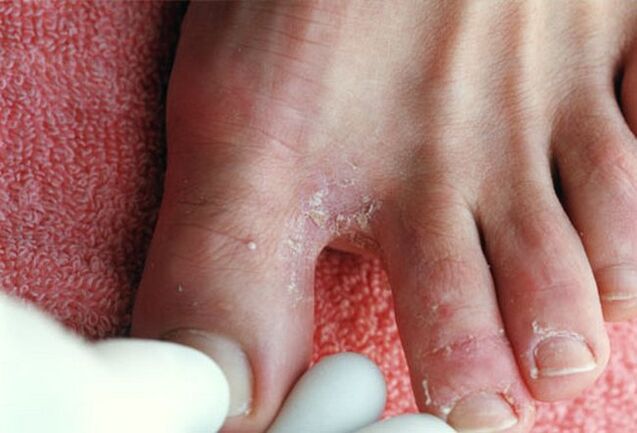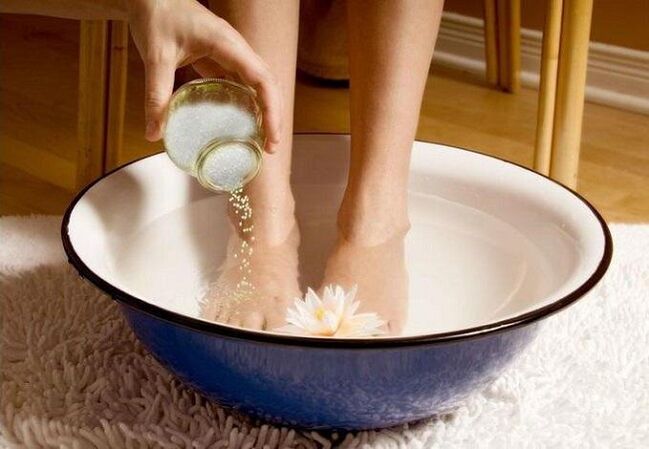In summer, excessive sweating and tight synthetic shoes cause diseases such as fungus. Weeping sores appear between the toes, which causes discomfort and an unpleasant odor. How to recognize the disease in time and get rid of it? What preventive measures will help you forget about the disease once and for all?
The main symptoms and forms of the disease

The interdigital fungus on the feet can be identified by the following signs:
- in some places the skin becomes dry, flakes, cracks appear;
- small blisters appear, as in an allergic reaction, which periodically open and exudate is released;
- diaper rash appears between the toes and on the side of the foot;
- convergence of the upper layers of the skin is observed in lesions;
- itching, discomfort, pain may occur.
To make an accurate diagnosis, you should always consult a doctor, because with different forms of yeast infection, the symptoms may differ. Further treatment of interdigital fungus depends on the type of disease:
- Weak form. It is characterized only by increased dryness of the skin, peeling and cracking.
- Squamous-hyperkeratotic. When the disease takes this form, there is a convergence of the upper layer of the skin in the affected areas, the appearance of redness, diaper rash, which causes itching and burning. If the big toes are affected, hard yellow calluses develop.
- Intertriginous form. Swelling and severe erosion occurs between the toes.
- Dyshidrotic. Weeping areas appear, bubbles with transparent contents are formed. The external symptoms are accompanied by very severe itching.
What does the fungus look like on the toes? With a soft form, it looks like the affected areas were dusted with flour. If the disease also affects the nail plate, you may notice thickening and yellowing of the nail, with more advanced forms - its deformation. At other stages, the skin becomes moist, ulcers and redness are clearly visible.
Causes of the disease

Most often, tight synthetic shoes lead to athlete's foot.
Fungi between and under the toes don't just happen. The most common reasons for its occurrence:
- Diabetes.
- Diseases of the cardiovascular system, blood circulation, veins.
- Decreased immunity.
- Synthetic bodycon shoes.
- Excessive sweating of the limbs.
- Infection from pedicure tools, shared towels, shower mats.
Sometimes it is enough to try on the patient's shoes to catch an unpleasant illness on his own. To prevent this from happening, carefully monitor your hygiene, take vitamins, do not buy shoes from thrift stores.
Which doctor should I see?
If you find the symptoms described above in yourself, you should immediately contact a dermatologist or mycologist. After the interview and visual examination, the doctor will order the necessary tests. Without laboratory research, it is impossible to know exactly what type of fungus caused the disease. Without this, the doctor will not be able to prescribe adequate treatment.
A laboratory study of the scraping of dead scales can answer the following questions:
- Is the fungus the cause of skin changes?
- What type of yeast infection caused the disease?
On average, a detailed study of the sowing takes about two weeks. After that, some topical preparations (gels, ointments) and tablets are prescribed.
Traditional medicine
For the treatment of interdigital fungus on the legs, the following are prescribed:
- Antifungal creams
- Ointments
- Tablets and capsules
- Local antiseptics
Allow to relieve inflammation, reduce scaling, allow anti-fungal agents to penetrate deep under the skin. They form a film that prevents reinfection.
Effectively destroy fungal spores thanks to the active ingredients.
Suppress the development of the disease. Active substances through the blood enter the horny tissues, accumulate there and destroy the spores of the fungus. You should not take it without a doctor's prescription, since the tablets are selected individually and have a long list of contraindications. For patients with liver disease, the use of these drugs is strictly prohibited.
Hydrogen peroxide, salicylic acid, sulfuric ointment.
Treatment for interdigital fungi on the feet is aimed at eradicating the infection that led to the yeast infection. Correctly selected drugs and observance of all doctor's prescriptions will help prevent recurrence of the disease in the future. In this case, it is imperative to follow a complete treatment, the duration of which can be from one to eight months, depending on the degree of the disease.
Folk remedies

Foot baths are very useful.
The use of folk remedies for fungus between the toes will significantly accelerate the healing process. Home treatment involves the use of various baths and compresses:
- Based on celandine.
- Coffee bath.
- Soda-based products.
- Vinegar baths and lotions.
- We remove the fungus with aloe juice.
- Effective compresses.
Celandine is a plant often used for skin conditions. The affected areas can be lubricated with vegetable sap. A bath based on this herb will help cure the fungus on the feet. Freshly cut celandine is poured with boiling water, cooled to room temperature, and the feet are immersed in water. After the procedure, you need to let your feet dry naturally, then blot with a towel, spread antifungal ointment, and put on clean cotton socks. You need to carry out such manipulations every day before bedtime.
Five tablespoons of ground coffee are poured with a liter of boiling water. After the mixture has cooled a little, the feet are lowered in turn for 30 minutes. each. Do not dry or rinse your feet. This remedy relieves itching and inflammation of the skin between the toes almost immediately. After a month, the symptoms of the fungus will disappear.
A two tablespoon bath and grated laundry soap will help soften rough skin and remove fungus. After the procedure, the keratinized skin is removed using a manicure tool. Such manipulations should be carried out daily, since there are fungal spores in the areas of dead skin. You can prepare this remedy in another way - dilute the baking soda with water until it becomes mushy and apply to the affected areas.
It helps to add a few tablespoons of vinegar essence to the water each time you wash your feet. Get rid of the fungus on the leg will help 9% table vinegar lotions, but be prepared for painful sensations during the procedure. However, this remedy is extremely effective. Remove the compress after 10-15 minutes, spread it with ointment and put on clean socks.
Agave (scarlet) leaves are cut, wrapped in foil and left in the refrigerator for a week. Then squeeze out the juice and lubricate the affected areas of the skin in the morning and evening. It should be used in combination with trays and ointments.
You can buy basic lead acetate solution at the drugstore. For the treatment of yeast infection, this agent is applied to gauze, applied to the affected area and wrapped with cling film. The exposure time does not exceed 20 minutes.
Treating wet fungus between the toes requires a special approach. All the manipulations are carried out in several stages:
- clean the area with blisters with hydrogen peroxide, a solution of potassium permanganate;
- medical bath;
- using a cream or ointment.
In advanced cases, a sterile dressing can be applied to prevent infection from entering an open wound and to prevent the spread of the yeast infection. The use of talcum powder is also shown in order to dry the affected area.
Treatment of the fungus between the toes with folk remedies is effective only in combination with drugs. By relying on unconventional methods, you run the risk of eliminating the symptoms, but not eliminating the cause of the disease.
Preventive measures
To prevent the return of the cured fungus on the skin of the toes, follow our recommendations:
- Go to a nail salon with your tool. When performing a hardware pedicure procedure, ask to have the disinfection performed with you.
- Never take someone else's towels, shoes, socks.
- Buy a special UV shoe dryer and use it every day.
- Do a pedicure in time and remove dead skin.
- Only buy high quality shoes by size.
- Pay special attention to foot hygiene.
- Use herbal baths for prevention.
It is also important to strengthen the immune system and take vitamins, walk in the fresh air, and eat enough fruits and vegetables.
The fungus on the skin of the toes is treatable, but it is a long process that requires a responsible approach on the part of the patient and strict adherence to all the doctor's prescriptions. Pay enough attention to your health and don't let the disease run its course!
















